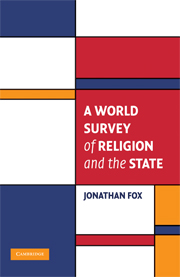Book contents
- Frontmatter
- Contents
- Acknowledgments
- 1 Introduction
- 2 The Question of Religion's Role in Politics and Society Modernization, Secularization, and Beyond?
- 3 Quantifying Religion
- 4 Global GIR from 1990 to 2002
- 5 Western Democracies
- 6 The Former Soviet Bloc
- 7 Asia
- 8 The Middle East and North Africa
- 9 Sub-Saharan Africa
- 10 Latin America
- 11 Patterns and Trends
- 12 Conclusions
- Appendix: Data Collection and Reliability
- Bibliography
- Index
11 - Patterns and Trends
Published online by Cambridge University Press: 05 June 2012
- Frontmatter
- Contents
- Acknowledgments
- 1 Introduction
- 2 The Question of Religion's Role in Politics and Society Modernization, Secularization, and Beyond?
- 3 Quantifying Religion
- 4 Global GIR from 1990 to 2002
- 5 Western Democracies
- 6 The Former Soviet Bloc
- 7 Asia
- 8 The Middle East and North Africa
- 9 Sub-Saharan Africa
- 10 Latin America
- 11 Patterns and Trends
- 12 Conclusions
- Appendix: Data Collection and Reliability
- Bibliography
- Index
Summary
As Chapters 5 to 10 have demonstrated in considerable detail, the relationship between religion and state is complex. Furthermore, the perspective from which one views this relationship influences one's conclusions regarding its nature. Chapter 4 provides a macro-level analysis that depicts a number of global trends. First, there has been little change in the basic structure of world government involvement in religion (GIR) – as measured by a state's official relationship with religion and the larger pattern of state treatment of religion. But there has been a shift toward more GIR when examining more specific manifestations of GIR, such as religious discrimination against minorities, regulation of the majority religion (religious regulation), and religious legislation. Second, there is a clear difference in the patterns of GIR between different religious traditions. Third, few states have separation of religion and state (SRAS), even when using relatively lax definitions of SRAS. Fourth, economic modernization is linked to higher GIR. Fifth, democracies are shown to have less GIR, on average, than nondemocracies.
However, the finer perspective employed in the regional and country breakdowns in Chapters 5 through 10, show that the macro-perspective does not present the entire picture. There are exceptions to each of the general trends revealed by the macro-level analysis. Some democracies have considerable levels of GIR. One of the world's most economically developed states, the USA, has a lower GIR score than any other state in the RAS database.
- Type
- Chapter
- Information
- A World Survey of Religion and the State , pp. 313 - 351Publisher: Cambridge University PressPrint publication year: 2008

